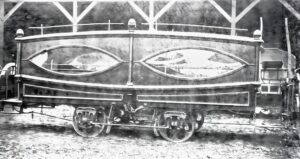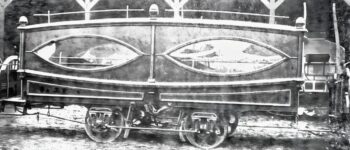1885: Government Tram of Death
July 12, 2024
By AHNZ

Government trying be venture capitalists tends to be stupid and a failure. Worse, it’s someone else who must pay for their mistakes and not the twits involved. How many times does New Zealand need to re-learn that government should not and cannot “pick winners?” You might like to think that the occasion upon which Christchurch City Council created its own Death Tram would end that argument but you’d be wrong.
Death Tram was the brainwave of one-term City Counselor James Bowman during the mayoralty of Charles Hulbert. Bowman, a Scot, of the big ‘L’ Liberal sort, had gotten himself on the Drainage Board and Cemetery Committee and set about hatching his plan. It was to use the Corporation Line, the city’s light rail used to transport emptied toilet contents (“night soil”) to move dead bodies at a cut-rate. Poor people would be able to take their final ride to Linwood Cemetery by renting this hearse on wheels.
I think it’s quite typical of the Liberal mindset to treat people like corporate entities part of one big soup rather than the individuals that they are. Cantabrians had their pride and, for a start, didn’t want their last journey to be conveyed on the same rails that carried the cities effluent away. Nor would a Christchurch citizen be caught dead going to their oblivion with the indignity of what Bowman branded as a poor man’s funeral. “The idea behind the scheme was to enable poor people to be given a cheap funeral.” Ref. Lamb, Press (1970)
Anyone could see that Bowman’s tram would, in very short order, acquire a disreputable sobriquet and carry the mortal reputations of any of its recently departed clients along the same lines. The possible permutations of words involving ‘death’ and ‘excrement’, ‘train’ and ‘poverty’ stagger the imagination. My calling it the ‘Death Tram’ is getting off lightly. Foreseeing this eventuality nobody wanted even to be first in line. Not even Cr. Bowman himself who had but 7 years to live.
Being Scottish and of an engineering bent of mind I don’t think Bowman had the empathy for how ill-received his tram would be. Practical people tend not to be sensitive to the human element which argues that even in death the human body is too sacred to be processed on a municipal production line alongside the civic effluent.
“THE TRAMWAY HEARSE, which the Christchurch City Council had built in 1885. It was never used for a funeral. The cost of the hearse and special tram lines was £400. and the total cost to the ratepayers was about £700. The hearse was finally sold for £3.” – Municipal Tramway Hearse Was Never Used, R.C. Lamb Press (1970,) Papers Past
“The tramway hearse was widely derided as a gimmick and was never used for its intended purpose. In 1888 it was suggested that the vehicle should be converted for use as a tramcar but was found to be unsuitable for this purpose and was eventually sold in August 1901.” – Wiki
“As well intentioned as the idea of a tramway hearse was, unfortunately, the concept of ‘funeral procession by public transport’ never ever took off and in the end, there would be no [under]takers keen on using it.” – End of the Line: short life and strange death of a white elephant, Christchurch Uncovered, Clara Watson (2023)
“A substantial loan was taken out by the council to cover the costs of the trams and the building of the tramline, which ran from the Council’s yard on Oxford Terrace, via Worcester Street, Linwood Avenue, and Buckleys Road to the new cemetery and the rubbish reserve.” – ibid
Thus, Death Tram was never taken up for its proposed purpose at all but was liquidated 16 years later. ‘Til then it languished uselessly taking up space but for a time serving as an expensive chook house. In the end it became the plaything of the local Member of Parliament’s children who turned it into a little house boat. Ref. Watson (2023)
The City had put the citizen into debt for this little White Elephant. According to Lamb (1970) the entire affair cost £700. Using the RBNZ inflation calculator (for what that’s worth) this sums to $165,374.81 in 2020s money. That’s less the £3 received on its sale in 1901 but probably not including the interest charged on the Hulbert administration borrowing the money in the first place.
It’s all fairly absurd and wasteful but very typical of the stupid Log-Rolling and pet projects New Zealanders put up with from their politicians. While unique in its outlandishness and missing of the mark it’s far from the worst way our supposed rulers have abused us over our long history of state interference.
—
Image ref. Christchurch Press (1970,) Christchurch Uncovered (2023,) AHNZ enhanced (2024)
Ref. Macdonald Dictionary Record: James Bowman, Canterbury Museum
Ref. Christchurch Uncovered, Clara Watson (2023)
 Like Comment Share
Like Comment Share





